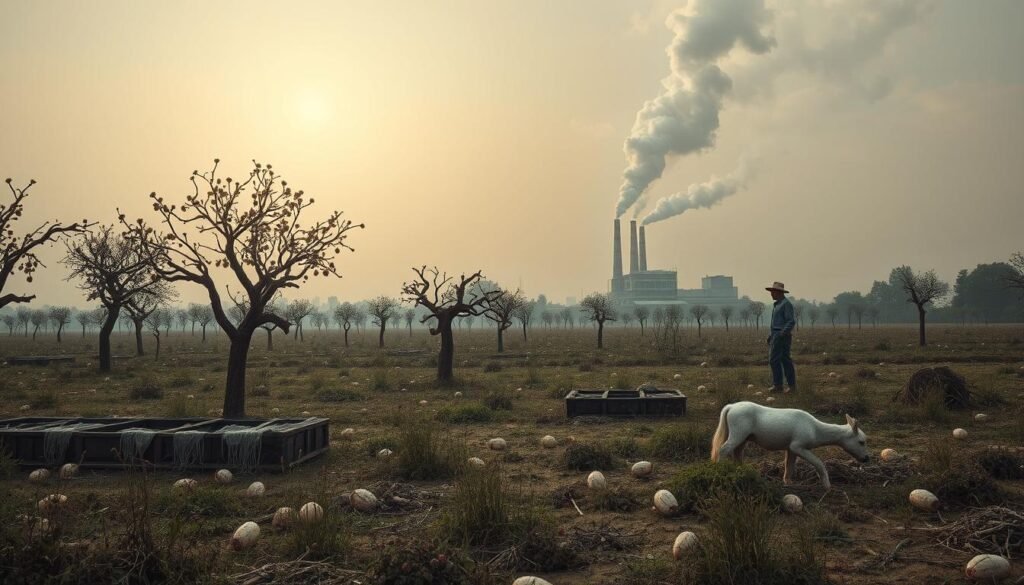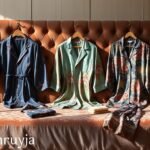Did you know that global silk production is around 202,000 metric tonnes each year? This is just 0.24% of all fibers used worldwide. The silk industry is facing more scrutiny for its environmental and ethical issues. Eco-friendly fashion is becoming more popular, pushing for sustainable textiles that are both quality and responsible.
This change is important for both brands and consumers. Traditional silk production harms the environment and ignores human rights. We will look into the trends making silk fabrics more sustainable. We will also talk about brands that focus on responsible sourcing.
For example, Tianruiyi makes custom silk pajamas from organic materials. They show that luxury and sustainability can go hand in hand. Let’s explore why sustainable practices are essential in the silk industry and the future of eco-friendly fashion.
Key Takeaways
- China dominates silk production, yielding nearly six times more than India.
- The sustainable silk market is small, with few producers and certifications.
- Organic silk producers are working hard to be eco-friendly under strict standards.
- New materials like spider silk and Piñatex are leading the way for sustainable options.
- High-quality custom silk products, like pajamas from Tianruiyi, focus on comfort and sustainability.
The Importance of Sustainable Fabrics in Fashion
The world is now more aware of the need for sustainable fabrics. About 300 million people work in the textile industry, many of them women. Using eco-friendly materials is key to protecting the environment and ensuring fair treatment for workers.
The textile industry uses a lot of water, more than many other sectors. Switching to materials like linen and bamboo helps save water and avoids harmful chemicals. Linen is good for the planet, and bamboo fabric grows fast and fights off germs.
Using recycled materials, like polyester fleece, shows the fashion world’s progress. It cuts down on plastic waste and supports recycling. Cupro fabric, made from old cotton, is a great example of reducing waste in fashion.
Choosing sustainable fabrics helps the planet and people. They cut down on pollution, protect nature, and save resources. Organic cotton and linen use much less water than regular cotton, showing why sustainability matters in fashion.
Brands that care about the planet also treat workers right. They pay fair wages and keep workplaces safe. Certifications like GOTS and OEKO-TEX Standard 100 prove their commitment to eco-friendly fashion.
Understanding Traditional Silk Production
Traditional silk production is key in the global textile world. It starts with raising silkworms on mulberry leaves. Countries like China, India, and Uzbekistan lead in silk making, each with their own special ways.
China is the biggest silk maker. It’s known for its fine silk making skills. India offers many silk types, showing off different local traditions. Its silk comes in many textures and colors, fitting many fashion needs.
Japan is famous for its detailed silk making. It creates soft fabrics like Habutai silk. Brazil’s silk is bright and shiny because of its warm weather. Uzbekistan’s silk is known for its quality and patterns, thanks to its long history.
Italy and France also play big roles in silk. Italy makes luxurious fabrics like brocade and velvet. France is known for its beautiful silk scarves and high-end fashion.
Silk is special because of its natural qualities. One cocoon can make a thread over a mile long. It’s strong like steel and keeps you warm or cool, depending on the season. But, making silk raises questions about fair labor and child work.
| Country | Specialty | Notable Silk Types |
|---|---|---|
| China | Largest producer | Mulberry silk |
| India | Diverse varieties | Tussar, Muga, Eri |
| Japan | Meticulous craftsmanship | Habutai silk |
| Brazil | Rainforest influenced | Lustrous silk |
| Uzbekistan | Rich heritage | Traditional patterns |
| Italy | High-end fashion | Brocade, Velvet |
| France | Haute couture | Silk scarves |
As more people want ethical and green textiles, knowing about traditional silk is important. It helps us understand its good and bad sides.
Environmental Impact of Conventional Silk Manufacturing
The silk industry is rich in tradition and luxury but faces big environmental challenges. Conventional silk production pollutes a lot and uses up resources. Growing mulberry trees for silkworms harms the land and local wildlife.
Traditional silk making uses a lot of water, more than plant-based options. The Higg Index shows silk has the biggest environmental impact among all textiles. Dyeing toxins add to pollution, affecting areas far from factories.
There are also ethical issues, like boiling silkworms alive. This raises big questions about silk’s sustainability. As the luxury market grows, so does the need for green practices and materials.
Brands are now looking for eco-friendly ways to make silk. They’re using enzymes to dye silk better and pollute less. Moving to sustainable materials like microsilk and plant fibers is a good step. More people want brands to think about the planet.
For more on sustainable silk, check out this resource. The debate on silk making is getting louder. It’s clear we need more ethical and green practices in the industry.
Sustainability Trends in Silk Fabrics
The textile industry is changing, focusing more on sustainability. People want products that are good for the planet. This shift is leading to more organic silk and peace silk, which are both cruelty-free and luxurious.
Emergence of Organic Silk
Organic silk is a big step forward in sustainable fabrics. It’s made without harmful chemicals, thanks to the Global Organic Textile Standard. This silk is better for the environment and farming practices.
It meets the needs of those who care about the planet but also want quality. Brands that use organic silk help consumers choose sustainable fabrics without losing luxury.
Peace Silk: A Cruelty-Free Alternative
Peace silk, or ahimsa silk, is a kinder choice for silk lovers. It’s made by letting moths come out of their cocoons before harvesting. This way, it’s both cruelty-free and luxurious.
Its popularity shows that people want ethical fashion. But, finding certified peace silk can be hard. Brands that use it are making a statement for sustainability and kindness.
| Silk Type | Production Method | Environmental Impact | Cruelty-free |
|---|---|---|---|
| Organic Silk | Grown without chemicals | Supports healthy ecosystems | Yes |
| Peace Silk | Allows moths to emerge | Reduces ethical concerns | Yes |
| Conventional Silk | Traditional harvesting | Associated with environmental issues | No |
Innovative Alternatives to Traditional Silk
The fashion world is changing, moving towards sustainable practices. This shift focuses on making clothes in a way that’s good for the planet and fair to people. Orange fiber, made from orange peels, is a great example. It shows how food waste can become something beautiful in fashion.
Bamboo silk is another great choice. It feels luxurious and is also good for the environment. This shows that fashion can be both stylish and sustainable.
Vegan Options: Orange Fiber and Bamboo Silk
Orange fiber and bamboo silk are leading the way in vegan silk alternatives. Orange fiber uses citrus waste to create a silky texture. It’s made with little water and energy, making it eco-friendly.
Bamboo silk comes from bamboo, which grows fast and needs little care. It’s breathable and keeps moisture away. These materials help reduce waste and promote better textile choices.
Next-Gen Silk Materials: Inspiration and Opportunities
The search for new materials is changing the fabric world. Companies like Bolt Threads and Orange Fiber are using bioengineering to create silk-like materials. These are made without harming animals and are better for the planet.
This focus on eco-friendly practices and new materials is shaping a sustainable future for fashion. It meets the need for clothes that are both stylish and responsible.
Learn more about sustainable fabrics and their role in fashion at this resource.
Challenges Faced by the Silk Industry
The silk industry is facing big challenges that threaten its future. A report from the Material Innovation Initiative pointed out several sustainability barriers. Traditional farming methods harm the environment and contribute to climate change.
Animal agriculture in the silk industry also has a big impact. It leads to environmental damage. This makes the industry’s effects on the planet worse.
Labor issues are another big problem. Child labor is a concern in some silk-producing areas. This raises serious ethical questions.
As silk demand grows, so do the costs. Raw material prices and production expenses are high. This makes synthetic materials like polyester more appealing, even though they harm the environment.
Innovators are trying to solve these problems. Companies like Alt Tex and AMSILK are creating new silk materials. They aim to make silk production more sustainable while keeping its quality.
But, changing the industry is hard. Old ways of doing things are hard to replace. It’s a big challenge to move to more sustainable methods.

Consumer Awareness and Ethical Choices
Consumer education is key in the fashion world’s move towards sustainability. As people learn more about the environmental and ethical sides of clothes, they want brands that care. This push for openness in how clothes are made has led many companies to use eco-friendly materials and start sustainable shopping plans.
Now, with options like lotus silk and other materials that break down easily, shoppers can help the planet. Lotus silk, for example, comes from lotus plants and needs little water and no pesticides. It’s a green choice that shows people are choosing to buy in a way that’s better for the earth.
Also, more people are into circular fashion, like recycling, upcycling, and buying second-hand. When they choose to wear clothes that have been worn before or rent them, they’re helping the planet. This change in how people shop is pushing the fashion world to be more green and fair.
| Fabric Type | Key Features | Environmental Benefits |
|---|---|---|
| Lotus Silk | Biodegradable, minimal water use | Water purification, no pesticides |
| Cactus Silk | Durable, crafted from agave | Environmentally friendly, low resource use |
| Bamboo Silk | Gentle on skin, soft texture | Rapidly renewable resource |
| Banana Silk | Versatile, natural shine | Utilizes agricultural waste |
The sustainable silk market is expected to hit $4 billion by 2030. This shows a big change towards making choices that are good for the planet. Brands are seeing that being green can also be good for their business. This change shows how important it is for fashion to be ethical.
Future of Sustainable Silk in Fashion
The future of silk in fashion looks bright, thanks to a growing need for sustainability. Designers are now looking for eco-friendly materials that feel as luxurious as silk but are better for the planet. This effort is a team effort between scientists, entrepreneurs, and designers, aiming to create textiles that are good for our planet.
AMSilk is leading the way by making spider silk using bacteria instead of silkworms. This silk is not only biodegradable but also doesn’t contain any petroleum-based materials. It’s becoming a popular choice for those who want sustainable fashion.

New materials like lotus silk and banana fiber are also gaining popularity. Lotus silk is made with very little water and no pesticides, showing a big commitment to the environment. Banana fiber, on the other hand, is soft and durable, similar to traditional silk but is biodegradable.
| Textile | Production Method | Environmental Benefits | Use in Fashion |
|---|---|---|---|
| Spider Silk | Recombinant Bacteria | Biodegradable, non-petroleum | High-end garments, accessories |
| Lotus Silk | Water-efficient Cultivation | Minimal water usage, no pesticides | Purses, clothing |
| Banana Fiber | Pseudostem Extraction | Biodegradable, low environmental footprint | Clothing, home textiles |
The fashion world is moving towards circular fashion, which promotes recycling and upcycling. This shift also brings more transparency and ethical labor practices. It’s a big step towards reducing the fashion industry’s carbon footprint, which is currently around 10% of global carbon dioxide.
As we look to the future, these new ways of making silk show a clear path towards more ethical and green manufacturing. By embracing these trends, the fashion industry can work towards a more sustainable future that benefits both people and the planet.
Conclusion
The silk industry is at a critical point, with a growing demand for sustainable silk fabrics. As people become more aware of the environment, companies must change their ways. This change leads to the use of eco-friendly methods and a focus on ethical fashion.
Technologies like waterless dyeing and biodegradable materials are changing silk production. Recycling advancements also help reduce fabric’s environmental impact. Companies using these technologies help lower emissions and support a circular economy in textiles.
The path to sustainability is long, but the impact we can make is huge. By supporting companies like Tianruiyi that value ethics, we push the silk industry forward. Together, we can make silk both beautiful and sustainable, preserving its place in fashion while caring for our planet.
FAQ
What are sustainable silk fabrics?
Sustainable silk fabrics are made in ways that are good for the planet and animals. They use organic farming and cruelty-free methods like peace silk. They also offer new ways to make silk that are better for the environment.
How does traditional silk production impact the environment?
Traditional silk making uses a lot of water and harmful chemicals. This harms the land and animals. It also involves killing silkworms, which is very wrong.
What is peace silk and how is it different from conventional silk?
Peace silk, or Ahimsa silk, lets silkworms come out of their cocoons alive. This is different from regular silk, where silkworms are killed. It shows a big difference in how silk is made.
Are there any vegan silk alternatives available?
Yes, there are vegan silk options like orange fiber and bamboo silk. They are made from things like orange peels and bamboo. They feel like silk but are better for the planet.
What challenges does the silk industry currently face?
The silk industry faces many problems. It uses a lot of energy and harms the environment. It also has bad labor practices and is hard to change.
How can consumers make more ethical choices in their silk purchases?
To buy silk ethically, look for brands that are open about how they make their silk. Choose sustainable silk options or second-hand silk. This helps the planet and supports fair labor.
What is the future outlook for silk in the context of sustainable fashion?
Silk’s future in green fashion looks good. More designers are choosing eco-friendly materials. New ideas will help silk become more sustainable and meet our desire for luxury that’s also kind to the planet.




